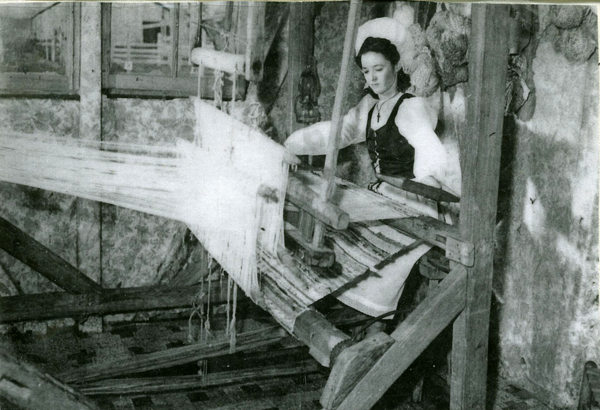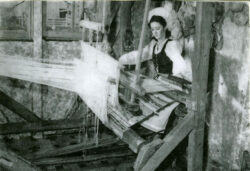Gladys LeBlanc Clark
Gladys LeBlanc Clark practices the Cajun folk tradition of spinning and weaving brown cotton.

Courtesy of The Acadian Museum
Gladys LeBlanc Clark at a young age. Unidentified
Gladys Clark was one of the few remaining traditional Acadian weavers of coton jaune or brown cotton. Clark continued a Cajun tradition of growing, spinning, and weaving cotton in order to create home textiles such as tablecloths, bedspreads, and decorative items. She demonstrated her skills at the Smithsonian Institution’s Festival of American Folklife in Washington, D.C., the New Orleans Jazz and Heritage Festival, and the Louisiana Folklife Festival, among other places. In 1997, the National Endowment for the Arts honored her contribution to the traditional arts with a National Heritage Fellowship.
Gladys LeBlanc was born October 31, 1918, in Lafayette Parish, one of nine children. Her father, Ambroise LeBlanc, was a farmer, and her mother, Colastie Hebert LeBlanc, was a spinner and weaver. As a child, Gladys learned quickly, taught the rudiments of her craft by her mother and encouraged by her aunt, paternal grandmother, and maternal great-grandmother, who were all spinners and weavers. Immersed in her rich traditional home life, Clark was able to card and spin cotton by the age of eight, and by her teens she was an accomplished weaver. She recalled the importance of carding, spinning, and weaving to social life: “All the ladies … could spin and weave. So they would have carding parties, la cardrie. Everybody would bring their cards and assemble all the chairs from the neighborhood. We would card all afternoon and they would serve lemonade and cookies. Mama would spin at night.”
When Gladys married Alexis Clark, her mother presented them with a full trousseau of bed linens. In turn, soon after Gladys’s own children were born, she began work on the trousseaus to be given to each of them when they married. A typical trousseau was prodigious and might include twelve blankets, two or three bedspreads, six sheets, twelve towels, one feather mattress covering, one bolster, and two pillows, plus three mattresses stuffed with Spanish moss.
Clark chose to use coton jaune, literally “yellow cotton,” though it has a brown appearance. This cotton distinguishes Cajun weaving. Brown cotton was common in southwestern Louisiana until the mid-nineteenth century, when the availability of commercial dyes eliminated its profitability, though the Cajuns continued to look to brown and white cottons and various shades of indigo dyes as their principal color sources.
In the 1940s, Clark and her LeBlanc family members became demonstrators and instructors in brown cotton weaving for Louisiana State University’s Louisiana Handicrafts Project, organized by Louise Olivier. Though interest in this project declined, it did open new markets for traditional arts outside the local communities in which they were made. Clark continued to grow, pick, seed, card, spin, and weave her own cotton on her farm with her husband, finding outlets for her handmade goods in local stores and by word of mouth. With the growing awareness of Cajun culture in the 1970s and 1980s, Clark began to present her work at festivals and museums.
By the 1990s, Clark had expanded the scope of her work. In addition to weaving domestic items, such as bed linens and table runners, she made scarves, which are not traditional within the Cajun community. Clark recalled: “The idea came from a friend who had visited France and brought some of my brown table runners to give as gifts to her relatives; one of the girls had put the table runner around her neck. My friend told her it was for the table, but she kept wearing it on her boater. So, that’s how I began making scarves—from the table runners.”
In 2006, Clark donated her loom and a collection of weaving-related materials to the Acadian Museum in Erath. Gladys LeBlanc Clark died on September 12, 2011 in Lafayette.
Adapted from a biography provided by the National Endowment for the Arts.
http://www.nea.gov/honors/heritage/fellows/fellow.php?id=1997_03&type=bio
